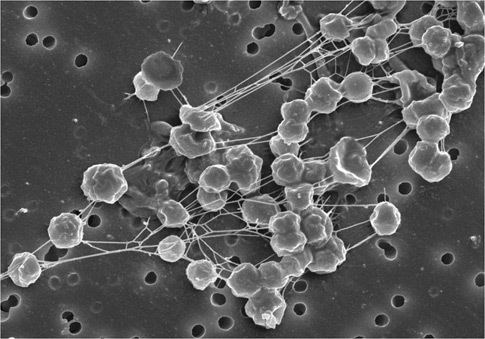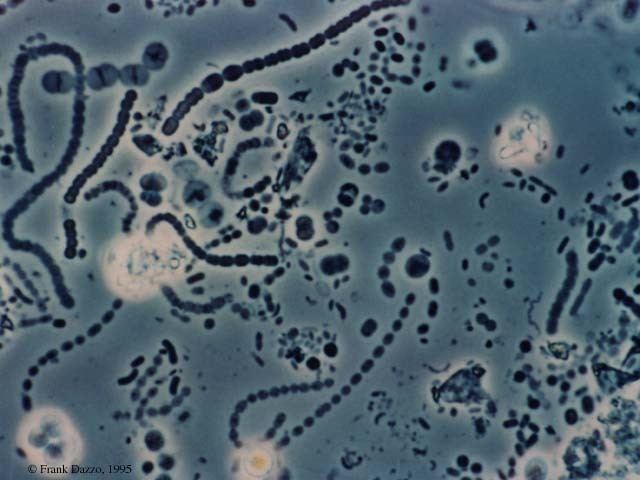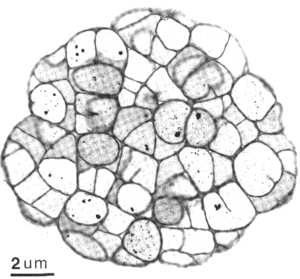 | ||
Representative species Methanosarcina barkeri, Methanocaldococcus jannaschii, Methanosarcina acetivorans, Methanobrevibacter smithii, Methanococcus maripaludis | ||
Methanogens are microorganisms that produce methane as a metabolic byproduct in anoxic conditions. They uniquely belong to the domain of archaea. They are common in wetlands, where they are responsible for marsh gas, and in the digestive tracts of animals such as ruminants and humans, where they are responsible for the methane content of belching in ruminants and flatulence in humans. In marine sediments the biological production of methane, also termed methanogenesis, is generally confined to where sulfates are depleted, below the top layers. Moreover, the methanogenic Archaea populations play an indispensable role in anaerobic wastewater treatments. Others are extremophiles, found in environments such as hot springs and submarine hydrothermal vents as well as in the "solid" rock of the Earth's crust, kilometers below the surface.
Contents
- Methanogenesis Intestinal Biosynthesis of Methane
- Methanogens
- Physical description
- Methanogens and extreme environments
- Comparative genomics and molecular signatures
- Fermentative metabolism
- Strains of methanogens
- References
Methanogenesis: Intestinal Biosynthesis of Methane
Methanogens
Physical description

Methanogens are coccoid (spherical shaped) or bacilli (rod shaped). There are over 50 described species of methanogens, which do not form a monophyletic group, although all methanogens belong to Archaea. They are anaerobic organisms and cannot function under aerobic conditions. They are very sensitive to the presence of oxygen even at trace level. Usually, they cannot sustain oxygen stress for a prolonged time. However, Methanosarcina barkeri is exceptional in possessing a superoxide dismutase (SOD) enzyme, and may survive longer than the others in the presence of O2. Some methanogens, called hydrogenotrophic, use carbon dioxide (CO2) as a source of carbon, and hydrogen as a reducing agent.
The reduction of carbon dioxide into methane in the presence of hydrogen can be expressed as follows:
CO2 + 4 H2 → CH4 + 2H2O
Some of the CO2 is reacted with the hydrogen to produce methane, which creates an electrochemical gradient across cell membrane, used to generate ATP through chemiosmosis. In contrast, plants and algae use water as their reducing agent.
Methanogens lack peptidoglycan, a polymer that is found in the cell walls of the Bacteria but not in those of Archaea. Some methanogens have a cell wall that is composed of pseudopeptidoglycan. Other methanogens do not, but have at least one paracrystalline array (S-layer) made up of proteins that fit together like a jigsaw puzzle.
Methanogens and extreme environments
Methanogens play the vital ecological role in anaerobic environments of removing excess hydrogen and fermentation products that have been produced by other forms of anaerobic respiration. Methanogens typically thrive in environments in which all electron acceptors other than CO2 (such as oxygen, nitrate, ferriciron (Fe(III)), and sulfate) have been depleted. In deep basaltic rocks near the mid ocean ridges, they can obtain their hydrogen from the serpentinisation reaction of olivine as observed in the hydrothermal field of Lost City.
The thermal breakdown of water and water radiolysis are other possible sources of hydrogen.

Methanogens are key agents of remineralization of organic carbon in continental margin sediments and other aquatic sediments with high rates of sedimentation and high sediment organic matter. Under the correct conditions of pressure and temperature, biogenic methane can accumulate in massive deposits of methane clathrates, which account for a significant fraction of organic carbon in continental margin sediments and represent a key reservoir of a potent greenhouse gas.
Methanogens have been found in several extreme environments on Earth - buried under kilometres of ice in Greenland and living in hot, dry desert soil. They are known to be the most common archaebacteria in deep subterranean habitats. Live microbes making methane were found in a glacial ice core sample retrieved from about three kilometres under Greenland by researchers from the University of California, Berkeley. They also found a constant metabolism able to repair macromolecular damage, at temperatures of 145 to –40 °C.
Another study has also discovered methanogens in a harsh environment on Earth. Researchers studied dozens of soil and vapour samples from five different desert environments in Utah, Idaho and California in the United States, and in Canada and Chile. Of these, five soil samples and three vapour samples from the vicinity of the Mars Desert Research Station in Utah were found to have signs of viable methanogens.
Some scientists have proposed that the presence of methane in the Martian atmosphere may be indicative of native methanogens on that planet.
Closely related to the methanogens are the anaerobic methane oxidizers, which utilize methane as a substrate in conjunction with the reduction of sulfate and nitrate. Most methanogens are autotrophic producers, but those that oxidize CH3COO− are classed as chemotroph instead.
Comparative genomics and molecular signatures
Comparative genomic analysis has led to the identification of 31 signature proteins which are specific for the methanogens (also known as Methanoarchaeota). Most of these proteins are related to methanogenesis, and they could serve as potential molecular markers for the methanogens. Additionally, 10 proteins found in all methanogens which are shared by Archaeoglobus, suggest that these two groups are related. In phylogenetic trees, the methanogens are not monophyletic and they are generally split into three clades. Hence, the unique shared presence of large numbers of proteins by all methanogens could be due to lateral gene transfers.
Fermentative metabolism
Although most marine biogenic methane is the result of carbon dioxide (CO2) reduction, a small amount is derived from acetate (CH3COO−) fermentation.
In the fermentation pathway, acetic acid undergoes a dismutation reaction to produce methane and carbon dioxide:
CH3COO− + H+ → CH4 + CO2 ΔG° = -36 kJ/reactionThis disproportionation reaction is enzymatically catalysed. One electron is transferred from the carbonyl function (e− donor) of the carboxylic group to the methyl group (e− acceptor) of acetic acid to respectively produce CO2 and methane gas.
Archaea that catabolize acetate for energy are referred to as acetotrophic or aceticlastic. Methylotrophic archaea utilize methylated compounds such as methylamines, methanol, and methanethiol as well.
